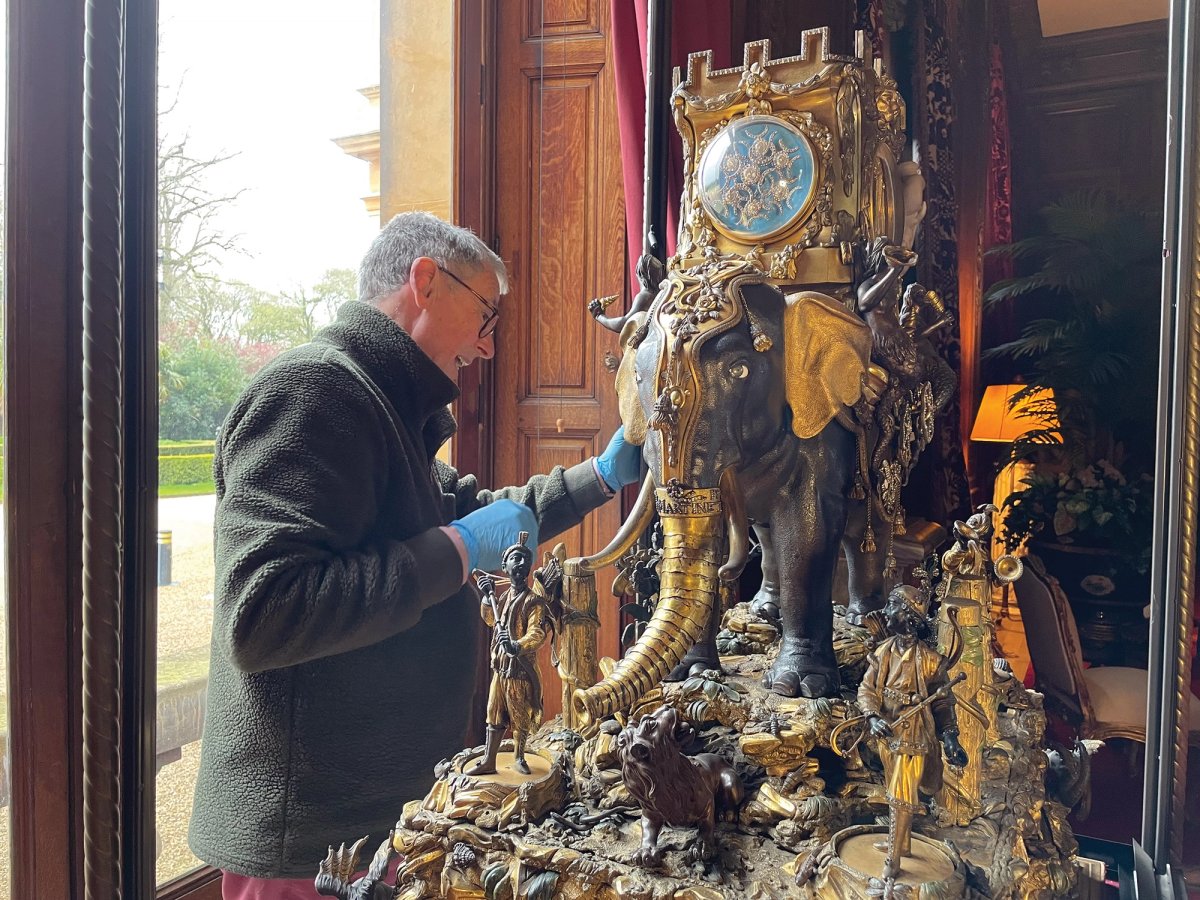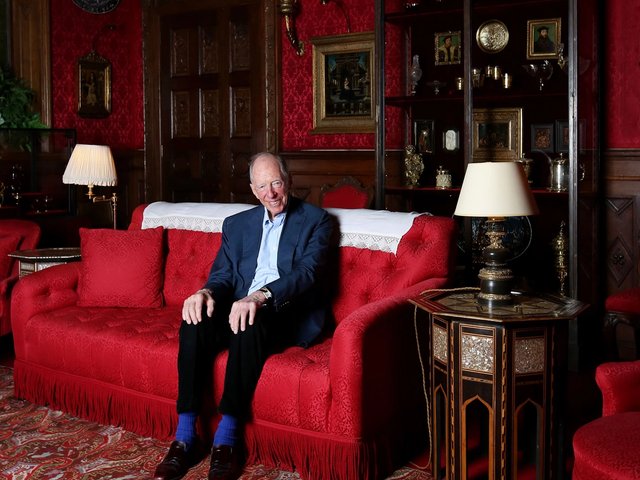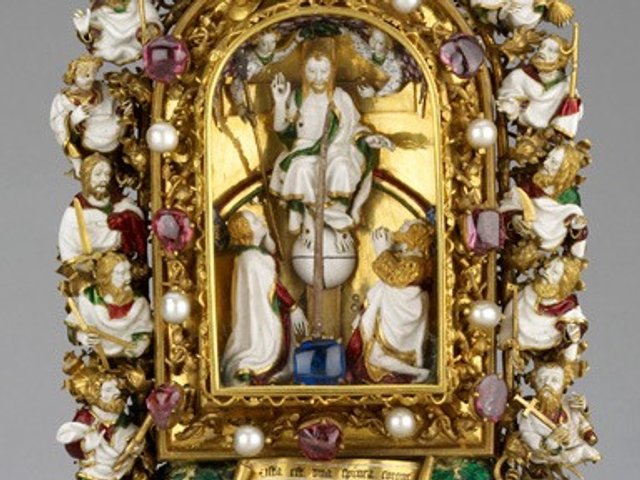When horologist Jonathan Betts first encountered the Waddesdon elephant, the wonderful Georgian toy had not rolled its eyes, flapped its ears or swung its great golden trunk for half a century.
He has just dismantled its thousands of moving parts for the third time, and, more importantly, put them all back together again. He has assembled tiny oriental figures traversing fingernail-sized bridges. There are crocodiles, gryphons, mermaids, beetles and a diamond-studded lily that furls and unfurls its petals. A tangle of snakes writhe among revolving stars, topped with a golden howdah hung with shivering crystal drops, occupied by a sultan turning slowly to study his kingdom—all to the incongruous accompaniment of tinkling tunes from the music box, which is concealed in the rocky shore on which the elephant stands.
Waddesdon Manor, an extraordinary Loire chateau built on the side of a Buckinghamshire hill and completed by Baron Ferdinand de Rothschild in 1883, is one of the National Trust’s most spectacular treasure houses, holding masterpieces of painting, furniture, silver, porcelain and textiles, many originally made for the royal families of Europe.
The elephant is an outlier: generally at Waddesdon, anything that looks gold is just that. All the diamonds are real. But the elephant is only a gilded toy, sparkling with paste stones. As with many of Ferdinand’s treasures, there are no records of when or where he bought it, or how much he paid, though Betts and the Waddesdon curator Mia Jackson believe he may have seen it in Paris and fallen under its spell, as so many have before and since.
A tussle with the Shah
The Shah of Persia, Naser al-Din Qajar, encountered the elephant at Waddesdon as a guest in 1889. He recorded the meeting in his travel journal, along with his opinion that the food at Waddesdon was “disgusting”, opining that the elephant was superior to all the “enamels, armour and Palissy ware” in the house. Ferdinand refused either to give or sell his new toy, so the Shah scoured Europe for another, and finally found a slightly less grand elephant with a clock instead of a music box—adding to his palace fittings that included a marble slide so his many wives could take turns to shoot down into his arms in a marble pool. That automaton left Iran in the 1920s, sold at a Bonham’s auction in 2002 for £250,000 and was last seen at a Sotheby’s auction, where it fetched £1.4m.
Much like the Shah, a century later Betts met the elephant and was entranced—and took on the daunting responsibility of keeping her moving. Betts comes from two generations of Ipswich clock and watch sellers, but instead of becoming a businessman as expected, he trained as a clockmaker, becoming senior conservator at the Royal Observatory in Greenwich and an internationally recognised expert on the Harrison clocks of Longitude fame. He earned an MBE for services to horology.
The elephant is both much older and less exotic than most viewers assume—it was made in Clerkenwell in London in 1772, the centre for generations of the clockmaking industry and also the birthplace of the Shah’s elephant, which was made by Peter Torckler’s workshop. The trunk is signed in fake diamonds by Hubert Martinet, the rival and, Betts thinks, a superior workshop owner who assembled the craftsmen specialists in clockwork, ormolu, sand-cast brass, mercury gilding and paste jewellery.
The elephant may have been intended as one of the expensive trinkets East India Company officers gave as gifts or bribes to local rulers
It may have been intended as one of the expensive trinkets East India Company officers gave as gifts or bribes to local rulers—where they were known as “sing songs”—but it did not sell. Instead, the elephant trundled across Europe in exhibitions and travelling shows, for the next century, and it still bears traces of some added garish fairground colours.
Betts and his research partner Roger Smith—who gained admission under sworn secrecy to a store in the Far East with a whole collection of sad, dusty automata, including the elephant’s twin—have been working on a book on its frustratingly gap-laden history. Occasionally they have found its tracks in Amsterdam or Paris, including an alley where admission to see “a monstrous five-year-old” cost twice as much as the gorgeous elephant.
All that is known of its earliest history at Waddesdon is that it was there by 1889, on the plinth specially built for its 200kg weight, when the Buckinghamshire Herald recorded that the Shah demanded it be wound up over and over again. It was sent out for repair work in the 1920s, possibly the only time it left the house since Ferdinand bought it, and there are accounts of it being set working to cheer up Second World War evacuee children. It may never have worked again between the war and Betts’s original encounter with it in the early 1990s.
After Betts dismantled, cleaned and replaced the worn-out Georgian screws—“generally very poor quality”, he sniffs—he repaired sagging chain drives and added minute drops of precious oil (£50 for a tiny bottle) to hundreds of oiling points. Since then, the two gilded keys that separately operate the automaton and the music box have been turned almost every month, bringing the elephant back to life.
The elephant no longer sings its original song, instead tinkling out five rather bland folk tunes. At some point, possibly when Ferdinand acquired it, the music box was so worn that its original tunes would no longer play, so the pins on the drum were shaved off and replaced. This time, Betts hoped to discover and possibly recreate the original music by scanning the scars of the original pins, but the scans failed to give a sharp enough impression—despite the ingenious idea of running it through an old fashioned fax machine to heighten the contrast.
“Oh no—I’ve just found this screw!” said the Waddeson head steward Jane Finch as the last glittering pieces were delicately reinstated, in the horrified voice of somebody almost completing a piece of Ikea flat pack. It was not a disaster: the screw was one of Betts’s spares. He tucked it away for next time, when he will be in his 80s and the elephant approaching its tercentenary. The drooping lily and the no longer contra-revolving daisy need attention in his own workshop at home. “I think I’ve probably got one more go on the elephant in me—I hope so anyway,” he says. “And you will get the flowers back—if I’m spared.”
• The elephant is on display in Christmas at Waddesdon, Waddesdon Manor, Aylesbury, until 1 January 2024





